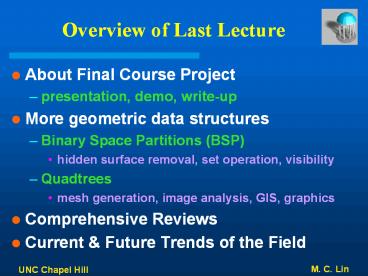Overview of Last Lecture PowerPoint PPT Presentation
1 / 12
Title: Overview of Last Lecture
1
Overview of Last Lecture
- About Final Course Project
- presentation, demo, write-up
- More geometric data structures
- Binary Space Partitions (BSP)
- hidden surface removal, set operation, visibility
- Quadtrees
- mesh generation, image analysis, GIS, graphics
- Comprehensive Reviews
- Current Future Trends of the Field
2
Binary Space Partitions
- Recursively splitting the plane (space) with a
line (hyperplane), which may cut the plane
(space) as well as the objects themselves. - The size of a BSP tree is the total number of the
object fragments generated by the partitioning - Auto-partition a BSP that uses only the cutting
lines (planes) to be the set of extensions of the
input segments. NOTE Auto-partition doesnt
always produce minimum-size BSP trees, but it
generates reasonably small ones.
3
Data Structure Analysis
- Let S be a set of n segments in a plane. A BSP
of size O(n log n) can be computed in expected
O(n2 log n). - For any set of n non-intersecting triangles in
R3, a BSP tree of size O(n2) exists. Moreover,
there are configurations for which the lower
bound size of any BSP is quadratic. Despite
this fact, in general, BSP trees perform
reasonably well.
4
Quadtrees
- Quadtree a rooted tree in which every internal
node has 4 children. Every node corresponds to a
square. - Construction split the current square into 4
quadrants, partition the point set accordingly,
and recursively construct quadtrees for each
quadrant with its associated point set. It stops
when the point set contains less than 2 points. - The point set is not necessarily split well. It
is possible that all points lie in the same
quadrant. Thus, a quadtree can be quite
unbalanced. It is not possible to express the
size and depth of a quadtree as a number of
points it stores. But, other quantification is
possible.
5
Data Structure Analysis
- The depth of a quadtree for a set P of points in
the plane is at most log(s/c) 3/2, where c is
the smallest distance between any two points in P
and s is the side length of the initial square
that contains P. - A quadtree of depth d storing a set of n points
has O((d1)n) nodes and can be constructed in
O((d1)n) time. - Let T be a quadtree with m nodes. Then, the
balanced version of T has O(m) nodes and it can
be constructed in O((d1)m) time.
6
Mesh Generation
- Simulation of heat transfer and interaction
between different media require FEM. Such method
requires dividing the region into small elements.
The accuracy and speed of FEM depends on the
mesh. - Non-uniform mesh generation (fine near the edges
of components and coarse far away from the edges)
can be generated using quadtrees. (Examples in
p.290-291)
7
Topics Covered
- Line-Segment Intersection
- 3D Morphing, thematic map overlay
- Polygon Triangulation
- guarding an art gallery, morphing
- Linear Programming
- manufacturing/molding, collision detection,
polygon simplification - Robustness Degneracies
- causes and solutions
8
Topics Covered
- Geometric Data Structures/Search
- range/window search using k-d trees, range trees,
interval trees, priority search trees, segment
trees, BSP, quadtrees, etc. - crystal structure determination, database query,
image queries, windowing/zoom - Point Location
- GIS, polygonization of parametric surfaces, path
planning
9
Topics Covered
- Voronoi Diagram
- post office problem, D. triangulation, CH
- Arrangements Duality
- computing discrepency, visibility graph
- Delaunay Triangulations
- height interpolation, constraint triangulation,
meshing, etc. - Convex Hulls
- optimal bounding volumes, V. region
10
Topics Covered
- Robot Motion Planning
- Minkowski sum, potential field methods,
approximate cell decomposition, visibility
graphs, etc. - distance computation, character animation, drug
design, image-guided surgery, radiosity
computation, etc. - Others
- subdivision surfaces, cloth simulation
11
Techniques Discussed
- Plane-Sweep
- Incremental Construction
- Randomized Algorithms
- Divide-and-Conquer Techniques
- Hierarchies Recursion
- Transform using Duality
12
Current Future Trends
- Toward simpler and efficient geometric data
structures and algorithms - Design consideration for the problem nature of
applications - More dynamic data structures (KDS)

